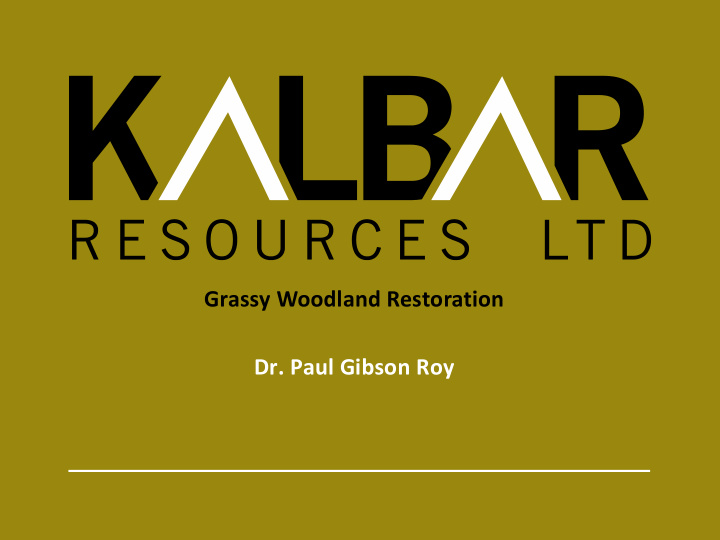



Grassy Woodland Restoration Dr. Paul Gibson Roy
WHY NATIVE GRASSY RESTORATION IS COMPATIBLE WITH MINERAL SANDS EXTRACTON ➢ Presents the opportunity to clearly define vision and goals for returning complex native flora to parts of the post-mined landscape. ➢ Resource companies can develop budgets that properly support the planning and implementation of restoration works. ➢ Projects are conducted over timelines and within rehab footprints that provide realistic opportunities for careful and considered restoration action and adaptive management. ➢ Mineral sands extraction offers a unique potential to carefully manipulate the post-mined landform and soil characteristics so that the seeding/planting surface is appropriate for restoration success (i.e. nutrient characteristics, weed seed banks, water holding capacity). ➢ Mining operations have systems, land access (e.g. for SPAs), equipment, infrastructure and people required to undertake complex and long-term land rehabilitation. ➢ Mining operations are obliged to work in close association with regulators, local agencies and communities ensuring inclusion for the broader community and a common interest and commitment to outcomes. 2
Rehab Zones Zone % Total Final land-use Species composition 80-90% improved pasture, 10-20% Plateau grazing 52% Grazing pasture native grasses Exotic pasture and native grass plus Plateau edges 9% Limited grazing native trees and shrubs Exotic pasture and native grass plus Valley slopes 15% Grazing exclusion for stability native trees and shrubs Riparian drainage lines. Native riparian trees, shrubs and Valley channels 2% Grazing exclusion for stability ground layer species Grassy Woodland 20% Native conservation area Composite native grassy woodland Functional, low maintenance, high amenity native ground Low growing native grasses and Road verge 2% layer vegetation high amenity native wildflowers
Rehab Zones
TEMPERATE GRASSY COMMUNITES At the time of European settlement native grasslands and grassy woodlands were widespread from southern Queensland to Victoria on a footprint now termed ‘the sheep - wheat belt.’ Because of their arable soils and open structure they were prime targets for modified exotic pastures and cropping. They now exist as less than 5% of their original extent occurring primarily on locations not utilized for agriculture. 5
NATIVE GRASSY WOODLANDS - STRUCTURE 6
INTACT GRASSY COMMUNITIES 7
MAIN COMPONENTS FOR GRASSY RESTORATION • Proper planning, resourcing and timelines. • Access to appropriate species diversity (primarily ground layer). • Access to seed in appropriate quantities and quality (wild or SPA). • Appropriate site preparation (weeds, soil nutrients, seed bed). • Appropriate seeding technology. • Appropriate timing of works. • Appropriate maintenance regime. 8
GROWING NATIVE SEED: SEED PRODUCTION • Seed Production utilizes well- established horticultural techniques to germinate and grow plants for seed. • Many species produce large amounts of seed in production. • Numerous genetic individuals can be grown in small areas. • SPAs reduce the impact of repeated collections on wild populations. • SPAs allows a high level of management control over variables that normally limit plant growth and seed production in the wild. 9
FIELD SCALE SEED PRODUCTION 10
FIELD SCALE SEED PRODUCTION 11
Example Restorations
CAMDEN – ELIZABETH MACARTHUR RESERVE 2016 AFRICAN LOVE GRASS DOMINATED 13
CAMDEN – ELIZABETH MACARTHUR RESERVE 2016 POST- SCALP 14
CAMDEN – ELIZABETH MACARTHUR RESERVE 2016 Seeding 15
CAMDEN – ELIZABETH MACARTHUR RESERVE 2018 Native Grassy Sward 16
NARELLAN – PARROTS FARM RESERVE 2013 African Olive Dominated 17
NARELLAN – PARROTS FARM RESERVE 2016 Olive Removal 18
NARELLAN – PARROTS FARM RESERVE 2016 Post- Olive Removal 19
NARELLAN – PARROTS FARM RESERVE 2016 Direct Seeding 20
NARELLAN – PARROTS FARM RESERVE 2017 Native Grassy Sward 21
NARELLAN – PARROTS FARM RESERVE 2018 – High Forb Diversity 22
ROADSIDE RESTORATION WICKLIFFE 2006
WICKLIFFE SITE 2: 2006
WICKLIFFE 2008
WICKLIFFE 2017
WICKLIFFE 2018
POTENTIAL BENEFITS 28
RECONSTRUCTING COMPLEX COMMUNITIES
RE-ESTABLISHING RARE AND BEAUTIFUL SPECIES
PROVIDING HABITAT FOR ANIMALS
WORKING WITH COMMUNITY
Thank you Enquiries : Dr. Paul Gibson-Roy Mobile: +61 37591097 Email: paul.gibsonroy@kalbarresources.com.au Kalbar Resources Limited ABN 30 149 545 362 www.kalbarresources.com.au
Recommend
More recommend